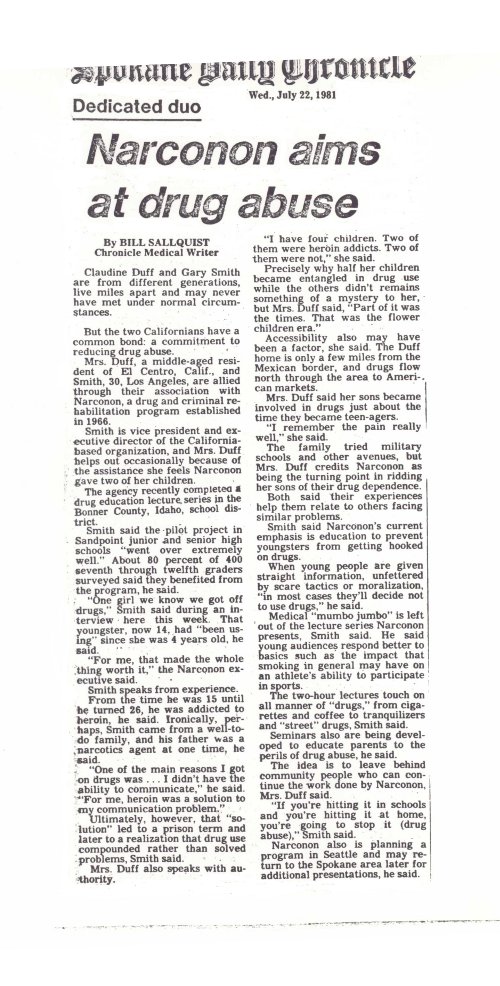Narconon aims at drug abuse

By Bill Sallquist
Chronicle Medical Writer
Spokane Daily Chronicle
Wed., July 22, 1981
Dedicated duo
Claudine Duff and Gary Smith are from different generations, live miles apart and may never have met under normal circumstances.
But the two Californians have a common bond: a commitment to reducing drug abuse.
Mrs. Duff, a middle-aged resident of El Centro, Calif., and Smith, 30, Los Angeles, are allied through their association with Narconon, a drug and criminal rehabilitation program established in 1966.
Smith is vice president and executive director of the California-based organization, and Mrs. Duff helps out occasionally because of the assistance she feels Narconon gave two of her children.
The agency recently completed a drug education lecture series in the Bonner County, Idaho, school district.
Smith said the pilot project in Sandpoint junior and senior high schools “went over extremely well.” About 80 percent of 400 seventh through twelfth graders surveyed said they benefited from the program, he said.
“One girl we know we got off drugs,” Smith said during an interview here this week. That youngster, now 14, had “been using” since she was 4 years old, he said.
“For me, that made the whole thing worth it,” the Narconon executive said.
Smith speaks from experience.
From the time he was 15 until he turned 26, he was addicted to heroin, he said. Ironically, perhaps, Smith came from a well-to-do family, and his father was a narcotics agent at one time, he said.
“One of the main reasons I got on drugs was… I didn’t have the ability to communicate,” he said. “For me, heroin was a solution to my communication problem.”
Ultimately, however, that “solution” led to a prison term and later to a realization that drug use compounded rather than solved problems, Smith said.
Mrs. Duff also speaks with authority.
“I have four children. Two of them were heroin addicts. Two of them were not,” she said.
Precisely why half her children became entangled in drug use while the others didn’t remains something of a mystery to her, but Mrs. Duff said, “Part of it was the times. That was the flower children era.”
Accessibility also may have been a factor, she said. The Duff home is only a few miles from the Mexican border, and drugs flow north through the area to American markets.
Mrs. Duff said her sons became involved in drugs just about the time they became teen-agers.
“I remember the pain really well,” she said.
The family tried military schools and other avenues, but Mrs. Duff credits Narconon as being the turning point in ridding her sons of their drug dependence.
Both said their experiences help them relate to others facing similar problems.
Smith said Narconon’s current emphasis is education to prevent youngsters from getting hooked on drugs.
When young people are given straight information, unfettered by scare tactics or moralization, “in most cases they’ll decide not to use drugs,” he said.
Medical “mumbo jumbo” is left out of the lecture series Narconon presents, Smith said. He said young audiences respond better to basics such as the impact that smoking in general may have on an athlete’s ability to participate in sports.
The two-hour lectures touch on all manner of “drugs,” from cigarettes and coffee to tranquilizers and “street” drugs, Smith said.
Seminars also are being developed to educate parents to the perils of drug abuse, he said.
The idea is to leave behind community people who can continue the work done by Narconon, Mrs. Duff said.
“If you’re hitting it in schools and you’re hitting it at home, you’re going to stop it (drug abuse),” Smith said.
Narconon also is planning a program in Seattle and may return to the Spokane area later for additional presentations, he said.